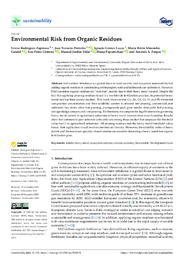Título :
Environmental Risk from Organic Residues |
Autor :
Rodríguez Espinosa, Teresa 
Navarro-Pedreño, Jose 
Gómez Lucas, Ignacio
Almendro-Candel, María Belén
PÉREZ-GIMENO, ANA
Jordan Vidal, Manuel M.
Papamichael, Iliana
Zorpas, Antonis  |
Editor :
MDPI |
Departamento:
Departamentos de la UMH::Agroquímica y Medio Ambiente |
Fecha de publicación:
2022-12 |
URI :
https://hdl.handle.net/11000/34772 |
Resumen :
Soil nutrient imbalance is a global threat to food security and ecosystem sustainability but
adding organic residues or constructing anthropogenic soils and technosols can optimize it. However,
FAO considers organic residues not “risk-free”, mainly due to their heavy metal content. Despite the
fact that applying pruning residues to soil is a worldwide fertilization practice, its potential heavy
metal risk has been poorly studied. This work characterizes Cu, Zn, Cd, Cr, Ni and Pb elemental
composition concentration and their solubility content in almond tree pruning, commercial peat
substrate, hay straw, olive tree pruning, pomegranate peel, pine needle, date palm leaf pruning,
sewage sludge compost and vine pruning. Furthermore, we compare the legal frameworks governing
heavy metal content in agricultural substrates to heavy metal concentration in each residue. Results
show that commercial peat substrate is the only one among those studied that surpasses the threshold
value for Cr in agricultural substrates. All pruning residues met the heavy metal threshold value;
hence, their application to soil involves minimal soil toxicity. Moreover, the solubility index of heavy
metals and the maximum quantity of each residue are crucial to discerning a heavy metal-free organic
fertilization plan.
|
Palabras clave/Materias:
soluble heavy metal
ecosystem services
circular economy
Sustainable Development Goals |
Área de conocimiento :
CDU: Ciencias aplicadas: Ingeniería. Tecnología |
Tipo de documento :
info:eu-repo/semantics/article |
Derechos de acceso:
info:eu-repo/semantics/openAccess |
DOI :
https://doi.org/10.3390/su15010192 |
Publicado en:
Sustainability 2023, 15, 192 |
Aparece en las colecciones:
Artículos Agroquímica y Medio Ambiente
|
 La licencia se describe como: Atribución-NonComercial-NoDerivada 4.0 Internacional.
La licencia se describe como: Atribución-NonComercial-NoDerivada 4.0 Internacional.
.png)
